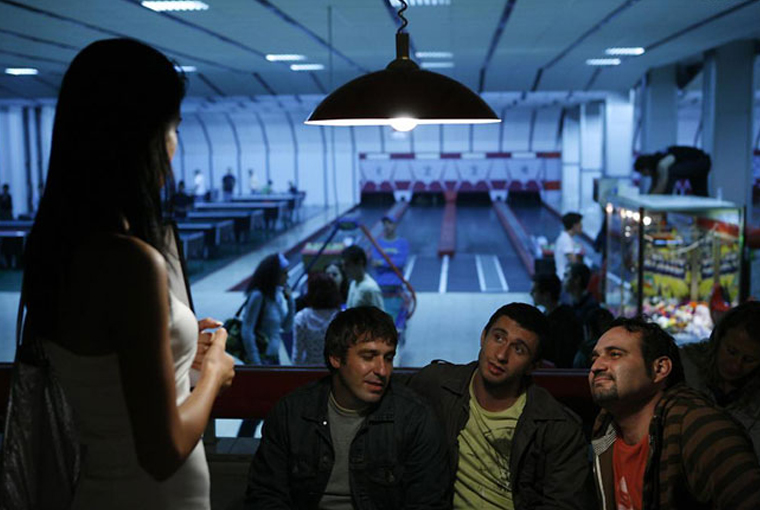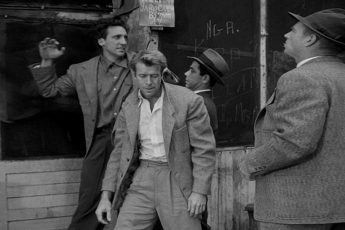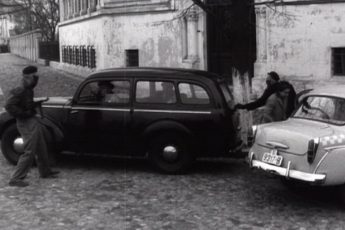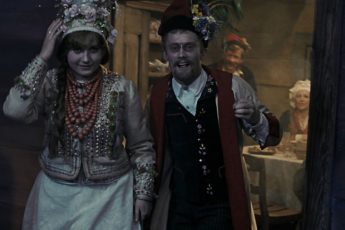
Arthur Schnitzler’s Dream Story from 1926 revolves around a married couple in early-twentieth-century Vienna. The story sets off at night, when the middle-aged pair – Fridolin and his wife Albertine – drift into a momentous conversation after putting their daughter to sleep. Fridolin and Albertine admit to having made brief, but pleasant encounters with the opposite sex at the ball they had attended the previous night. This seemingly harmless confession from the two leads to the memory of far more significant events from a holiday they had spent in Denmark. Recollecting a young man who stayed at the same hotel as the couple during their stay, Albertine tells Fridolin she had exchanged looks with him, and, at that moment, felt ready to give up the marriage with Fridolin for the love of the stranger. Though somewhat reluctantly, in return, Fridolin tells Albertine about a young girl he had approached on the beach while taking a morning walk, and how, after moving away from her after the brief, worldess encounter, he had been taken by an emotion so gripping he “was not far from fainting.”1
Much of the novel’s appeal lies in such episodes – both imagined and real. Though from the very beginning, the book plays with dream-like memories from the past, the novel further detaches from everyday life in the course of the story. Fridolin, bewitched by the events of the previous days, winds up at a mysterious masquerade ball held by a closed society. Though he spots a woman without whom he refuses to leave, upon being spotted, the intruder is soon forced out. His persistent endeavors to clarify the mysterious gathering will prove ineffective. At home, Fridolin wakes Albertine from a dream when he finds her laughing aloud in her sleep. As he insists on hearing the dream, Albertine begins telling him about the dream in which she betrays Fridolin. The swaying relationship between Albertine and Fridolin finally tips over, and Fridolin decides to take vengeance. Though he is given several occasions – the love of Marianne – the daughter of a deceased patient-, a haphazard run-in with some young men on the street, a prostitute whom he follows to her home, and, finally, the mysterious ball he is taken to by a friend from college -, Fridolin cannot fulfill his wish to “betray, to deceive, to lie, to play a part […] before the whole world.”2 In the end, his wish for revenge is broken by remorse, and the two reconcile. “I think we ought to be grateful that we have come unharmed out of all our adventures, whether they were real or only a dream,”3 Albertine says to her husband…
Though many contemporary critics saw the novel as an homage to the unshakable and eternal institution of marriage, more recent interpretations render such a view obsolete and naive. Rather, Schnitzler seems to be interested in the up-and-down dynamics of an ordinary, well-situated house hold. Besides, it is hardly appropriate to assess the remorse-stricken return of Fridolin to his wife as a happy ending. Schnitzler gives the reader no reason to believe that this delayed reconciliation is motivated by love. As Hee-Ju Kim lays forward in her analysis (Reclam), Fridolin is presented as an anti-hero from the very beginning of the novel, even in the memories that reach beyond his marriage with Albertine. He returns to his wife not because his love for her overrode his libido, but because his inferiority complex overrode his courage. Those who are unfamiliar with Schnitzler’s novel may know Stanley Kubrick’s meticulous adaptation Eyes Wide Shut, in which Kubrick largely remains loyal to the original story line. Tom Cruise, in the role of Dr. Harford, essentially acts as a pendant to Fridolin in New York of the 1990s (the film was shot in 1999), an anti-hero of an upper-class American house-old.
In many ways, Radu Muntean’s Boogie, too, is yet another take on this narrative. Muntean’s film tells the story of a young couple – Bogdan (or Boogie, as his friends call him), a tough, well-built man, and Smaranda, who is more responsible, but also more pale, – who are taking a vacation on the sea-side (the couple is acted out by the sovereign duo Dragos Bucur and Anamaria Marinca). Though the film opens with an illustration of the notorious troubles Romanian fathers seem to face in the upbringing of their children, with Boogie dictating the way his son should build his sand castle (notice that the Dream Novel, too, opens with a scene related to the child of Fridolin and Albertine), the vacation seems more or less harmonious until Boogie bumps into friends he hasn’t seen in years. Here, too, it is the past that befalls the characters and shall change the more or less harmonious course of their lives. Enthusiastic about the pleasant coincidence, Boogie takes Smaranda and the child to dinner with his two friends. As the scene unfolds, we soon realise that – as she will later confess – Smaranda does not feel comfortable in the presence of Boogie’s friends. She pushes Boogie to leave, and when he presses on staying longer by himself, she tries to make him feel guilty. Though Boogie keeps on drinking with his friends, he heads home early where his wife awaits him in a firece mood. As one may have expected at this point, the scene escalates, and Boogie rejoins his friends for more drinking, and, eventually, for some “fun” with a hooker. Still, the film ends with moderate reconciliation, and the ambiguous confession of Smaranda that she had not put things the right way during their argument…
Though essentially, Dream Story and Eyes Wide Shut are about disillusionment as opposed to the illusion of a happy marriage, for Muntean even the illusion of happiness itself as presented by both Schnitzler and Kubrick seems incompatible with current Romanian reality. In Boogie, masquerade balls are replaced by pool halls, and an over-worked Romanian businessman takes the place of a well-off private doctor. Schnitzler’s playful language and Kubrick’s over-aestheticised set-design are substituted for sober, hand-held camera work and on-location sets. Besides differences in the way the protagonists are nuanced (unlike Fridolin and Dr. Harford, Boogie does fulfill the act with the prostitute), another notable difference is the position of the woman. The Dream Story, and, more explicitly, Eyes Wide Shut, consciously construct the story from the perspective of the man in order to then confront it. “Oh, if you men knew!”4 Albertine exclaims in the Dream Story. It is this charge that Fridolin and Dr. Harford must face: that their women, too, are just as much subject to silent desires as they are themselves. In Boogie, this element is fully disregarded. Neither is Smaranda jealous of Boogie because she suspects him of sleeping with other women, nor are her own desires made explicit in the film. It is almost as if she specifically cared for Boogie not to have fun. Though I have previously raised this worry in conversations with Romanian directors, they did not seem keen on agreeing with my view that women shared a peripheral role in the New Wave. To me, even if Romanian society is patriarchical, it still seems interesting that its cinema deals with women much less explicitly than French, Italian or Czech cinema did when they flourished.
Nonetheless, though the stylistic stigmas of what has been known as the Romanian New Wave are applicable to Boogie, too, there are notable differences between Boogie and films like 4 Months, 3 Weeks, 2 Days or The Death of Mr. Lăzărescu. Muntean’s story revolves around his characters, not the world they exist in. Though there are truisms like “Nothing is the way it used to be” that can be induced from Boogie (for instance from the fact that the relationship between Boogie and his friends seems complicated by his wife), such banal “political” observations would do the film little justice. Unlike Muntean’s earlier film, The Paper Will Be Blue, this film is hardly connected to the political or even social reality of Romania. Instead, Boogie, like his most recent film Tuesday after Christmas, is above all a character based drama. Here, though the axioms of Romanian New Wave reality are set out (most notably mis-communication), the film does not investigate social or political maladies. It is almost as if Muntean had already passed that stage, as if he was prefiguring post-RNW cinema. Following such a reading, it seems that Muntean was not only disillusioning Western audiences, but Eastern audiences, too. What Muntean’s film implies is that the way out of economic and social instability does not solve problems, but instead, it shifts them. Fundamental questions become – at least if taken superficially – essentially unimportant ones. However, the question now becomes whether we did not already know this from the Dream Story and Eyes Wide Shut.
Perhaps, Muntean just wanted to do what was already discussed earlier on: cast a shadow over his story. In the end, nothing is solved, but not in the sense that the characters could not break free and therefore nothing has changed. Everything has changed, and yet the characters are where they set off at the beginning of the story. The dreams that Schnitzler employs in his novel are not not ones that will yield to everyday reality. They haunt reality in its very routine. Indeed, it is almost as if something had been added to the everyday reality. Thus, in Boogie, the conclusion that “nothing is the way it used to be” applies not just to the friendship of the three former friends that has turned awkard. What has become different is the reality that Fridolin, Dr. Harford, and Boogie tried to escape. Be it for the better, or the worse…




Leave a Comment